Slotless MagRacing Oval Track
59 posts
• Page 1 of 4 • 1, 2, 3, 4
Re: Slotless MagRacing Oval Track
These things on an oval would be way cool. You may have to stretch the chassis to put them under a sedan body but that shouldn't be too hard for anybody who hangs out around here. Wes says that weight is an issue but one of the paper dirt style late models would be a light weight natural and of course any of the vacuform bodies like those Smith Scale Raceway sells would be cool too. I would be more interested in the ASA style asphalt cars using 2nd and 3rd gen Camaros. Once a person got this down, I don't see any reason that it couldn't be scaled up to 1/24 which would give you more room for more battery which might allow you more weight or more power depending on how you set it up. Wes' mag steer set up is the only thing that sets this apart from any other garden variety RC car. I bet a person could transfer the steering coil alone over to another RC car. WES sells the steering coil and spindles separately and currently the prices are pretty cheap. I would love to buy a dozen of these cars and relegate half to oval and the other half to road racing. As it is, I have one car coming and my local slot buddies have two more on order. One of those guys is into ovals so there may be a chance there for some roundy round racing. I ordered four of the recommended 10440 Li-ion batteries and a charger for $25 bucks for my car so these batteries don't cost an arm and a leg. The car with controller is $117 bucks with lone cars available at $60 bucks so it is affordable to get into. The current radio set up is switchable and can run enough channels to run a pretty big field on any track. We found and ordered a 139 ft coil of .028 dulcimer wire for less than $14 bucks plus $5.00 shipping on ebay. That ought'a make a decent sized track with some wire left over. The price is right now it is time to sit back and wait for delivery.
-

Nor Cal Mike - HRW SlotCar Veteran!
- Posts: 1270
- Joined: Wed Sep 05, 2012 2:15 pm
Re: Slotless MagRacing Oval Track
NorCal-
Do you have a car *in-hand* or a tracking number? Just curious if these are actually shipping yet?
Overall I agree with everything you say and I am pretty enthusiastic - but it is sometimes very hard to be an 'early adopter'. You know, it sounds great but it could be a GITNIP (Good in Theory Not In Practice).
I assume these cars are very lightweight - do you know what they weigh (with batteries or w/o)?
I really do want to get my hands on a car (and a track) and try it out, and also hear firsthand accounts from real slot car hobbyists, and their persepectives.
When they are shipping I will probably buy one or two and take it from there.
Do you have a car *in-hand* or a tracking number? Just curious if these are actually shipping yet?
Overall I agree with everything you say and I am pretty enthusiastic - but it is sometimes very hard to be an 'early adopter'. You know, it sounds great but it could be a GITNIP (Good in Theory Not In Practice).
I assume these cars are very lightweight - do you know what they weigh (with batteries or w/o)?
I really do want to get my hands on a car (and a track) and try it out, and also hear firsthand accounts from real slot car hobbyists, and their persepectives.
When they are shipping I will probably buy one or two and take it from there.
-
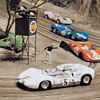
Vintage 1/24 - Mr. NY Modified
- Posts: 505
- Joined: Thu Sep 06, 2012 8:40 am
- Location: Long Island, NY
Re: Slotless MagRacing Oval Track
Yup I do have one in hand. It arrived on Friday. I sent in the order the previous Saturday so just under a week is pretty fast coming from England to California. Here is a pic of the chassis. 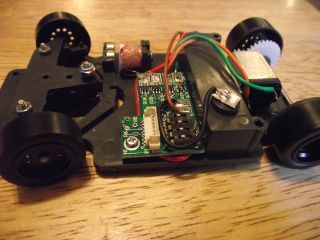
And a pic of the steering.
 Top Side
Top Side
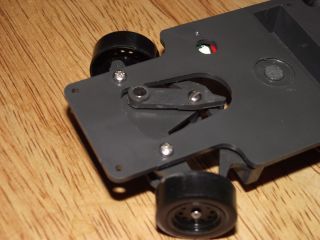 Bottom Side
Bottom Side
Here is a pic of the back end
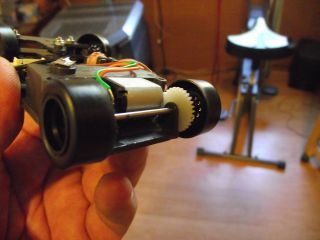
The picture isn't great but you may notice that the motor is pretty small. It is more like a 1/43 motor. It doesn't have proper mounts but is glued right down to the pan. Another thing that was a surprise to me is that the wheels/ and tires are one piece plastic and are hollow on the back side. This seems kind of cheezy at first but when you understand Wes' big picture it makes sense. Speed, weight and available traction are deliberately restricted to make his racing system more scale like. This may be hard for slot racers to adjust to given that they cut their teeth on racing cars that go 3-4 times faster then they should go in scale speed. For tinkerers, I think there might be some adjusted in Wes' car but not much given the single 10440 Li-ion 3.6 v battery (AAA in size) that powers this car and the size of the car itself. Available watts is the defining factor. Doubling the watts can give you double the speed, double the load capacity or double the time before a recharge is necessary. Take your choice but you have to find room to store those watts. This car as delivered is a 1/32 Can Am car and it's wheelbase is only 2 1/4" wide X 3" long. There's not much room to spare. More space battery storage could be achieved by stretching the chassis to fit an American sedan sized body which happens to fit right in with oval racing. I don't know much about it but perhaps another style of battery intended for RC might be chosen as well. If you scale this car up to 1/24 you have a lot more battery room also.
More Pics.
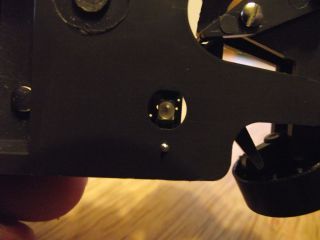
The chassis has a hole in the bottom which a receiver mounted LED points through to the track surface. This is for a timing system that Wes hasn't yet released.
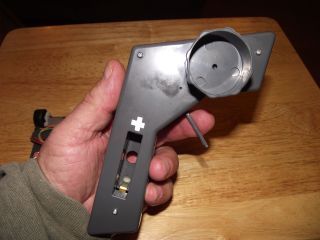
The controller won't win any ergonomic awards but the trigger is very smooth and light of touch. My hands are big so it is OK for me but for small hands maybe not so much.
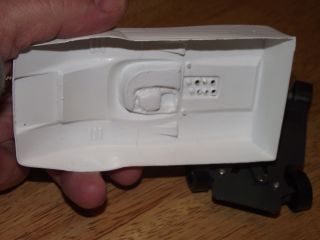
The body is vacuform to save weight.
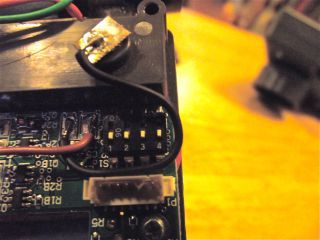

The transmitter and receivers have a series of small numbered switches to set frequency. My understanding is there are up to 16 combinations to allow that many cars race.
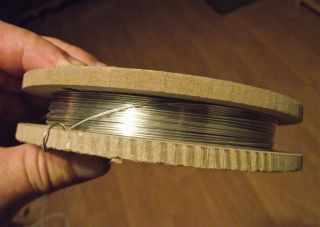
Here is a 239' roll of .028" music wire that I bought on Ebay. It cost about $14 bucks plus $5 shipping. I am almost ready to start track building. This wire is placed just under the track surface and is used to guide the magnet tiller which drives the car in passive steering mode. From and operators perspective it drives more like a digital slot car. From the car's perspective, the car has to drive around the track by the available grip of its front wheels. There is no slot to anchor the car.
To sum it up, this car is pretty simple by RC standards. Only Wes' mag steer system sets it apart from the rest. Could Wes steering technology be transfered to other more sophisticated RC cars? Maybe so. Would that make the racing better? I don't know. I do think that there is some elegance to this simplicity. I believe that it has room for tinkering and tinkering is something, especially this for group on the oval forum, has plenty of ability for.

And a pic of the steering.
 Top Side
Top Side Bottom Side
Bottom SideHere is a pic of the back end

The picture isn't great but you may notice that the motor is pretty small. It is more like a 1/43 motor. It doesn't have proper mounts but is glued right down to the pan. Another thing that was a surprise to me is that the wheels/ and tires are one piece plastic and are hollow on the back side. This seems kind of cheezy at first but when you understand Wes' big picture it makes sense. Speed, weight and available traction are deliberately restricted to make his racing system more scale like. This may be hard for slot racers to adjust to given that they cut their teeth on racing cars that go 3-4 times faster then they should go in scale speed. For tinkerers, I think there might be some adjusted in Wes' car but not much given the single 10440 Li-ion 3.6 v battery (AAA in size) that powers this car and the size of the car itself. Available watts is the defining factor. Doubling the watts can give you double the speed, double the load capacity or double the time before a recharge is necessary. Take your choice but you have to find room to store those watts. This car as delivered is a 1/32 Can Am car and it's wheelbase is only 2 1/4" wide X 3" long. There's not much room to spare. More space battery storage could be achieved by stretching the chassis to fit an American sedan sized body which happens to fit right in with oval racing. I don't know much about it but perhaps another style of battery intended for RC might be chosen as well. If you scale this car up to 1/24 you have a lot more battery room also.
More Pics.

The chassis has a hole in the bottom which a receiver mounted LED points through to the track surface. This is for a timing system that Wes hasn't yet released.

The controller won't win any ergonomic awards but the trigger is very smooth and light of touch. My hands are big so it is OK for me but for small hands maybe not so much.

The body is vacuform to save weight.


The transmitter and receivers have a series of small numbered switches to set frequency. My understanding is there are up to 16 combinations to allow that many cars race.

Here is a 239' roll of .028" music wire that I bought on Ebay. It cost about $14 bucks plus $5 shipping. I am almost ready to start track building. This wire is placed just under the track surface and is used to guide the magnet tiller which drives the car in passive steering mode. From and operators perspective it drives more like a digital slot car. From the car's perspective, the car has to drive around the track by the available grip of its front wheels. There is no slot to anchor the car.
To sum it up, this car is pretty simple by RC standards. Only Wes' mag steer system sets it apart from the rest. Could Wes steering technology be transfered to other more sophisticated RC cars? Maybe so. Would that make the racing better? I don't know. I do think that there is some elegance to this simplicity. I believe that it has room for tinkering and tinkering is something, especially this for group on the oval forum, has plenty of ability for.
Last edited by Nor Cal Mike on Mon Dec 10, 2012 10:17 am, edited 1 time in total.
-

Nor Cal Mike - HRW SlotCar Veteran!
- Posts: 1270
- Joined: Wed Sep 05, 2012 2:15 pm
Re: Slotless MagRacing Oval Track
What is the weight? The plastic tires/wheels make me think this is a very light car.
Thanks for all the pix and info.
Thanks for all the pix and info.
-

Vintage 1/24 - Mr. NY Modified
- Posts: 505
- Joined: Thu Sep 06, 2012 8:40 am
- Location: Long Island, NY
Re: Slotless MagRacing Oval Track
Hey Mike,thanks for the info and pictures.I've been interested in this system from day one.Let us know how she runs once you get you track done.I see an Oval in the future if these run as they look like they do.No more one lane being faster..
Rusty
Rusty
-
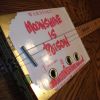
ourwayband - HRW SlotCar Veteran!
- Posts: 2471
- Joined: Wed Sep 05, 2012 12:10 pm
- Location: West Tennessee
Re: Slotless MagRacing Oval Track
I don't know te weight. Wes doesn't list it and I don't have a scale. Holding it without a body or battery in one hand and a rolling Carrera chassis in the other hand, they feel about equal in weight. The body is much lighter so when the battery is loaded the mag car and the slot car would be roughly equal. Eventually I will likely experiment with high quality slot car wheels probably fitted with harder rubber compounds like OEM slot car tires out back. The front is trickier because the front spindles are centered in the wheel (neutral wheel offset) so the tie rod extends inside the inner tire edge. It may require thinning down the tie rod to fit inside a typical 15" sizes slot car wheel. Larger wheel diameters like 17 or 18 inch wheels are probably OK. It is might possible to adapt finer machined spindles like those found on Mini Z's to this car too. The key is linking the tie rod to the mag tiller and mounting the two button magnets on the tie rod so that the active RC steering.
Primer on this RC steering system:
Here is how I figure this thing works. The car has two steering systems, a passive steering that is activated by the magnetic tiller (similar placement as a slot car guide) which follows a wire under the track surface and an active RC steering system. In order for the passive steering to work efficiently, the entire steering assembly must work with as little friction as possible. To do that, there is no mechanical linkage to the active RC steering to cause drag in the system. The active RC steering works by mounting two small button magnets to the tie rod. Mounted to the chassis in close proximity behind the tie rod is a steering coil which is actually an electro magnet whose polarity can be reversed by reversing the electrical current through the coil (this is done via the RC control) With the current flow going one way, the coil attracts the tie rod mounted magnets. When the current is reversed, it repels them so the tie rod moves left or right. This RC steering is not proportional as in higher end RC cars but proportional steering is unnecessary given that the active system is only meant to shunt the car to a diagonal guide wire that works like a crossover slot in a digital slot car track. The active steering is weak compared to the passive steering making it subservient, This means that the operator cannot steer the car away from the guide wire except in places where this is allowed by a cross over. How that works is another paragraph which I won't go into now. I will explain it if asked.
Primer on this RC steering system:
Here is how I figure this thing works. The car has two steering systems, a passive steering that is activated by the magnetic tiller (similar placement as a slot car guide) which follows a wire under the track surface and an active RC steering system. In order for the passive steering to work efficiently, the entire steering assembly must work with as little friction as possible. To do that, there is no mechanical linkage to the active RC steering to cause drag in the system. The active RC steering works by mounting two small button magnets to the tie rod. Mounted to the chassis in close proximity behind the tie rod is a steering coil which is actually an electro magnet whose polarity can be reversed by reversing the electrical current through the coil (this is done via the RC control) With the current flow going one way, the coil attracts the tie rod mounted magnets. When the current is reversed, it repels them so the tie rod moves left or right. This RC steering is not proportional as in higher end RC cars but proportional steering is unnecessary given that the active system is only meant to shunt the car to a diagonal guide wire that works like a crossover slot in a digital slot car track. The active steering is weak compared to the passive steering making it subservient, This means that the operator cannot steer the car away from the guide wire except in places where this is allowed by a cross over. How that works is another paragraph which I won't go into now. I will explain it if asked.
-

Nor Cal Mike - HRW SlotCar Veteran!
- Posts: 1270
- Joined: Wed Sep 05, 2012 2:15 pm
Re: Slotless MagRacing Oval Track
I ordered some cars last week so I guess I will join the other early adopters when they arrive.
I will probably just build up a very basic, simple oval first as a "test of concept" and see how much fun these things are to play with - then take it from there.
I will probably just build up a very basic, simple oval first as a "test of concept" and see how much fun these things are to play with - then take it from there.
-

Vintage 1/24 - Mr. NY Modified
- Posts: 505
- Joined: Thu Sep 06, 2012 8:40 am
- Location: Long Island, NY
Re: Slotless MagRacing Oval Track
Interesting system, and I've watched this for awhile. One thing I was thinking of was just using continuous rail like the HO guys do when routing tracks. It would seem easier to me than the method their video uses. Curious to see what you guys think when you get them running.
-
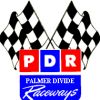
dreinecke - King of the Dum-Dums!
- Posts: 7360
- Joined: Wed Aug 08, 2012 5:39 pm
- Location: Colorado
Re: Slotless MagRacing Oval Track
I have cars in hand. It took about a week to get them from the U.K.
The specialized batteries/charger arrived in about three days - ordered through Amazon.
They are indeed toy-like, light weight, with hard plastic low-grip tires, and (oddly for an RC car) no reverse - which I think I might miss in a slot-less environment. The cars are described and photographed in an above post by NorCal.
I will try to build up a simple test track to get the feel of how these things actually "play".
If I like the "experience" and see some potential, then I guess I will take a spare car, "cut one up" and a make 1/24 scale racer and see how that works out...
The specialized batteries/charger arrived in about three days - ordered through Amazon.
They are indeed toy-like, light weight, with hard plastic low-grip tires, and (oddly for an RC car) no reverse - which I think I might miss in a slot-less environment. The cars are described and photographed in an above post by NorCal.
I will try to build up a simple test track to get the feel of how these things actually "play".
If I like the "experience" and see some potential, then I guess I will take a spare car, "cut one up" and a make 1/24 scale racer and see how that works out...
-

Vintage 1/24 - Mr. NY Modified
- Posts: 505
- Joined: Thu Sep 06, 2012 8:40 am
- Location: Long Island, NY
Re: Slotless MagRacing Oval Track
Islip Speedway will be the inspiration for my slot-less oval track (of course).
ISLIP SPEEDWAY 1966 (with Dragstrip) –

Looking closely, I can make out the actual *racing line* from the oil/rubber marks that were captured in this 1966 aerial photo way back when.
BTW "HistoricAerials.com" is a great resource - I now have shots of my favorite 1/5 mile speedway from 1954, 1966, 1969, and 1980.
ISLIP SPEEDWAY 1966 (with Dragstrip) –

Looking closely, I can make out the actual *racing line* from the oil/rubber marks that were captured in this 1966 aerial photo way back when.
BTW "HistoricAerials.com" is a great resource - I now have shots of my favorite 1/5 mile speedway from 1954, 1966, 1969, and 1980.
-

Vintage 1/24 - Mr. NY Modified
- Posts: 505
- Joined: Thu Sep 06, 2012 8:40 am
- Location: Long Island, NY
Re: Slotless MagRacing Oval Track
I had seen some of the early reports on this technology. It was quite interesting to me. Now it sounds like this is coming to fruition and it is quite interesting.
After reading NorCal Mike's description of his interpretation of how there is a multiple system for steering inputs to the cars, if I understand him correctly, it could lend itself to some of the most realistic type dirt oval racing I have ever seen in a scale mode.
I have to assume that if one were to put say 4 wires under the track's surface and have them very close to one another at the entry to the turn, then fan out into 4 realistic paths through and exiting the turn, converge at the entry to the other turn and finally fan out once again would basically provide all sorts of interesting racing with this type of car.
As the car is entering the corner, steering input could be used to assist the car in selecting the line into, through and out of the turn, much like the prototypes do on real tracks. I think this could be a true blast.
Let me know if my understanding of the capabilities of this technology is not what I am assuming. I would appreciate that.
After reading NorCal Mike's description of his interpretation of how there is a multiple system for steering inputs to the cars, if I understand him correctly, it could lend itself to some of the most realistic type dirt oval racing I have ever seen in a scale mode.
I have to assume that if one were to put say 4 wires under the track's surface and have them very close to one another at the entry to the turn, then fan out into 4 realistic paths through and exiting the turn, converge at the entry to the other turn and finally fan out once again would basically provide all sorts of interesting racing with this type of car.
As the car is entering the corner, steering input could be used to assist the car in selecting the line into, through and out of the turn, much like the prototypes do on real tracks. I think this could be a true blast.
Let me know if my understanding of the capabilities of this technology is not what I am assuming. I would appreciate that.
-

Florida_Slotter - Scratch Build Guru
- Posts: 1941
- Joined: Wed Sep 05, 2012 4:08 pm
- Location: Florida
Re: Slotless MagRacing Oval Track
Florida_Slotter -I think NorCal is fooling around with a very similar arrangement.
I have been playing with a simple test track made our of 1/4" MDF board - and it really is *much simpler* than routing a traditional wood slot car track. I used a Dremel cutoff saw and added a "foot pad" so it only lightly cuts the MDF board to the depth of the wire (very thin 22swg piano wire). I just drew pencil lines on the MDF and free-handed the cuts - it just gently scores the surface - but it works great, the wire fits very tightly in position - barely needs glue.
Embedded Wire –

I also have done a few preliminary tests and I already have a modified 1/28 scale Ferrari which weighs 144 grams following the wire. The MagRacer cars are light - only 70 grams total. It seems like I may be able to make the leap to something like a brass chassis 1/24 scale slot car - which weigh in around 150 grams... Too early to tell but promising so far. More magnet, more tire, and thicker wire, seems very plausible at this point, if one wanted to run fast brass chassis cars based on 1/24 hard body kits for example.
French curves - Freehand "Routing", and Some Toy Cars –

Happy New Year to all - I will post up some hot laps soon.
I have been playing with a simple test track made our of 1/4" MDF board - and it really is *much simpler* than routing a traditional wood slot car track. I used a Dremel cutoff saw and added a "foot pad" so it only lightly cuts the MDF board to the depth of the wire (very thin 22swg piano wire). I just drew pencil lines on the MDF and free-handed the cuts - it just gently scores the surface - but it works great, the wire fits very tightly in position - barely needs glue.
Embedded Wire –

I also have done a few preliminary tests and I already have a modified 1/28 scale Ferrari which weighs 144 grams following the wire. The MagRacer cars are light - only 70 grams total. It seems like I may be able to make the leap to something like a brass chassis 1/24 scale slot car - which weigh in around 150 grams... Too early to tell but promising so far. More magnet, more tire, and thicker wire, seems very plausible at this point, if one wanted to run fast brass chassis cars based on 1/24 hard body kits for example.
French curves - Freehand "Routing", and Some Toy Cars –

Happy New Year to all - I will post up some hot laps soon.
-

Vintage 1/24 - Mr. NY Modified
- Posts: 505
- Joined: Thu Sep 06, 2012 8:40 am
- Location: Long Island, NY
Re: Slotless MagRacing Oval Track
It's good to see you progress. You will be burning laps in no time I think. Did you see Keld's videos over on the Magracing forum? http://www.magracingforum.com/ He just got a test track set up and had his local club to a test session with 16 cars going around at once. I am really into this although I am not satisfied with the detail or the plastic "ness" of the set up as Wes is currently marketing it. But this is brand new and I am sure that when the enthusiasts get into it, change will come. I for one think that we can use a harder compound of rubber tire and still have to drive the car correctly to keep from spinning off of the course. That means we can use proper slot car wheels axles and gears. I am high enough on this thing that it could replace slots but that doesn't mean I won't still be in the market for slot cars and parts. By then, I will be looking at my slot cars as subjects for conversion to mag racing.
I laid the first wires for my track today. It isn't an oval but I will show it anyway. I started on the cork screw section of my attic road track. Basically, I stapled card stock over the slot car track putting a bunch of staples along the lines where the wire is and glued the music wire to that. Wes recommends filling between the wires with card stock or plaster of paris. I am going to try sheetrock topping compound. You can see the best line option.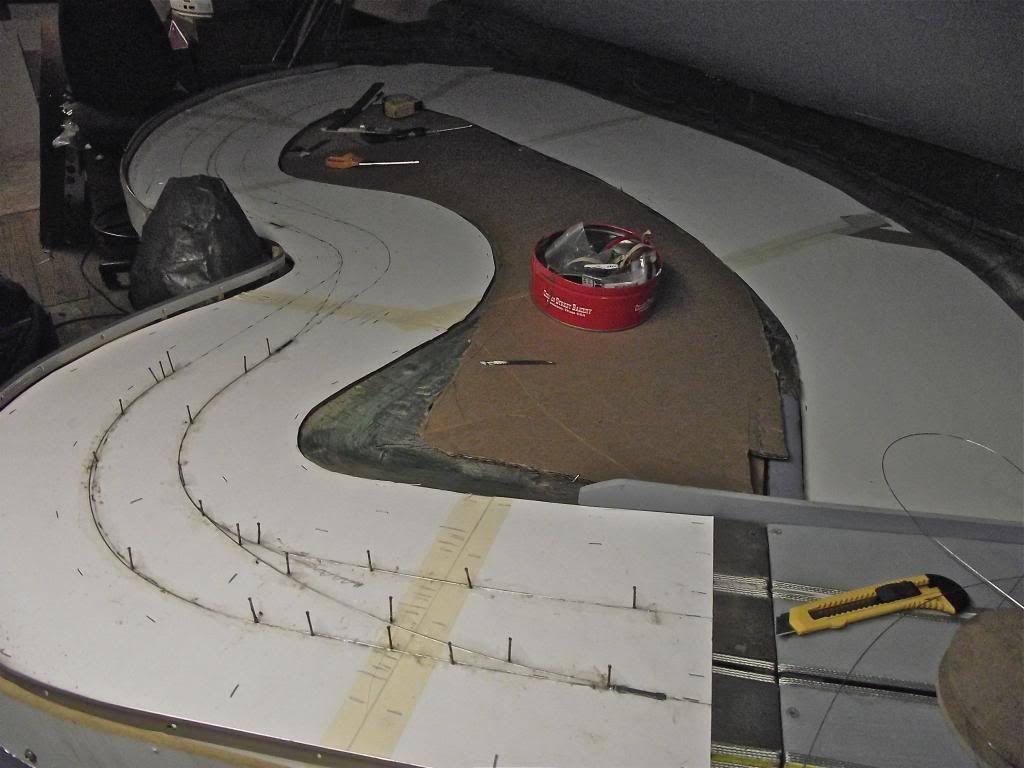
Here is a drawing of the fanned wires that Florida Slotter mentioned. There are a lot of other possibilities as well I think.
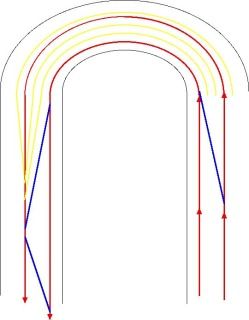
If the car slides off of the primary line it could get picked up by the next or the next one after that (yellow lines). Could a car be able to drift from line to line? Inquiring minds want to know.
Mike
I laid the first wires for my track today. It isn't an oval but I will show it anyway. I started on the cork screw section of my attic road track. Basically, I stapled card stock over the slot car track putting a bunch of staples along the lines where the wire is and glued the music wire to that. Wes recommends filling between the wires with card stock or plaster of paris. I am going to try sheetrock topping compound. You can see the best line option.

Here is a drawing of the fanned wires that Florida Slotter mentioned. There are a lot of other possibilities as well I think.

If the car slides off of the primary line it could get picked up by the next or the next one after that (yellow lines). Could a car be able to drift from line to line? Inquiring minds want to know.
Mike
-

Nor Cal Mike - HRW SlotCar Veteran!
- Posts: 1270
- Joined: Wed Sep 05, 2012 2:15 pm
59 posts
• Page 1 of 4 • 1, 2, 3, 4
Who is online
Users browsing this forum: No registered users and 1 guest
